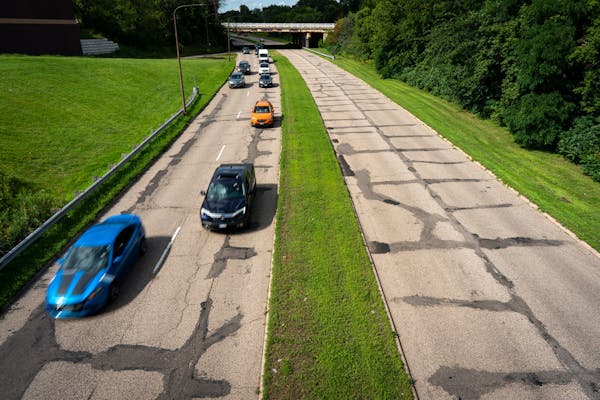A divided St. Paul City Council on Wednesday voted to repair Ayd Mill Road's crumbling pavement and add a greenway for bicyclists and pedestrians this year.
The council in February approved a $7.5 million plan to fix the roadway and turn one of its four lanes into a greenway, with the caveat that the Public Works Department had to complete traffic modeling and hold community meetings.
A March public meeting on Ayd Mill Road was canceled due to COVID-19, but public works created video presentations and received more than 1,200 comments — most of which expressed support for the plan, Interim Public Works Director Paul Kurtz told council members. "We reached many, many more people than we would have with in-person community meetings," he said.
Still, some council members — including Rebecca Noecker, who introduced an amendment eliminating the proposed greenway — said they were concerned about the project's funding, design and impact on adjacent neighborhoods.
Council President Amy Brendmoen and council members Mitra Jalali, Nelsie Yang and Jane Prince opted to move forward with the greenway.
Though "this is by no means a perfect design," Prince said, "I feel it is critically important in 2020 to commit to a multimodal corridor on Ayd Mill Road."
Ayd Mill has been the subject of decades of planning and public input.
The council approved a $3.5 million mill and overlay of Ayd Mill Road last year, but plans changed when Mayor Melvin Carter requested $5.2 million in his 2020 budget to turn two of four lanes into a greenway.
Council members chose not to include Ayd Mill in the 2020 budget, and in February, former Public Works Director Kathy Lantry told them a two-lane greenway would cost about $9.8 million because of drainage problems and other issues.
The $7.5 million alternative was a response to the increased cost, Lantry said, and a compromise for critics concerned about traffic being diverted onto residential side streets.
The one-lane greenway is expected to increase traffic diversion during the morning and evening rush hours, Kurtz said, but mitigation strategies such as re-timing traffic signals and changing lane configurations at intersections will help.
Emma Nelson • 612-673-4509

How Minnesota House Republicans ended the DFL's state government trifecta
Project 2025 platform proposal aims to allow mining in Boundary Waters watershed

Ann Johnson Stewart wins special election, giving DFL control of Minnesota Senate

Democratic U.S. Sen. Amy Klobuchar defeats GOP challenger Royce White

